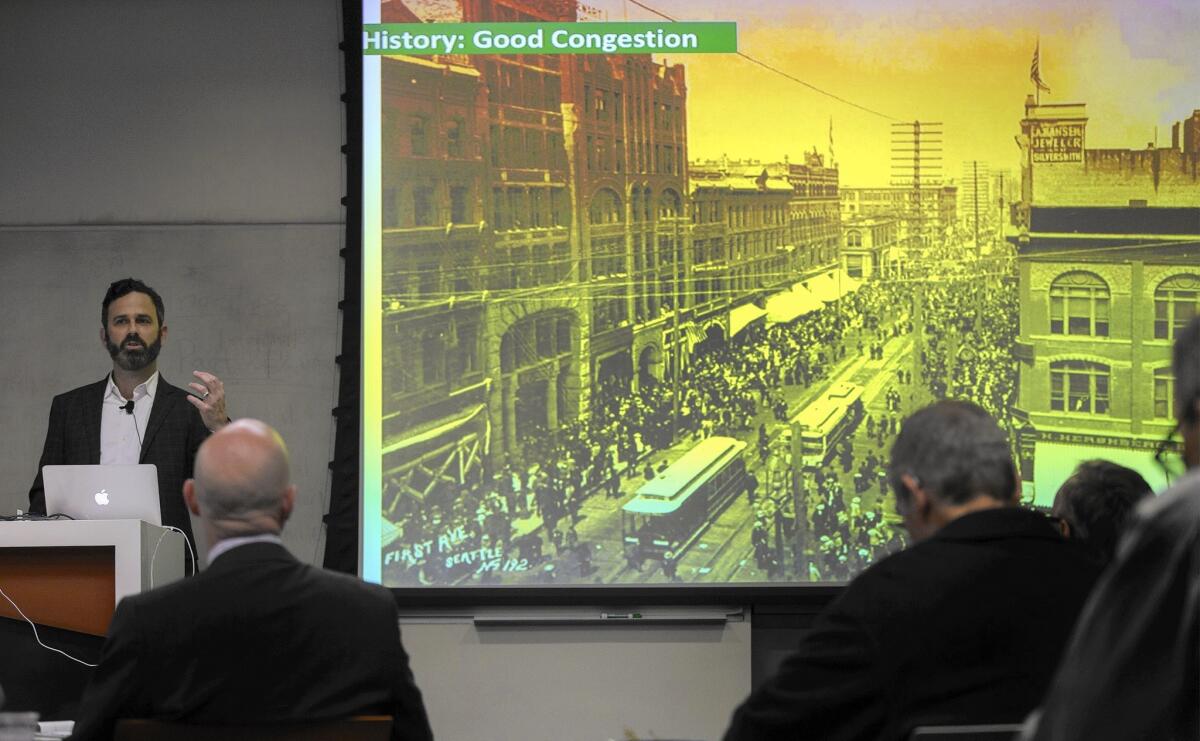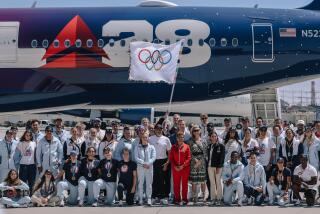California Commute: Driverless vehicles and the future of L.A. transportation

Gabe Klein, an author and futurist, speaks on the importance of communities to plan for the self-driving vehicle in a talk at UCLA on Nov 19.
Gabe Klein knows a few things about commuting. At 44, he is an author, futurist, government consultant and former head of the Chicago and Washington, D.C., transportation departments. He grew up in his family’s bicycle business, eventually became a vice president of Zipcar, the car sharing company, and is now with Fontinalis Partners, a venture capital firm co-founded by William C. Ford Jr., the great-grandson of Henry Ford and executive chairman of Ford Motor Co. Fontinalis focuses on technology and transportation-related start-ups.
Over the years, Klein has become an advocate of alternative modes of transportation, which, he says, are now entering the mainstream. Among other things, he set up bike-share operations in Chicago and the nation’s capital. At Zipcar, he built one of the largest car-sharing systems in the country in Washington. Klein’s ideas about urban transportation are contained in his new book “Start-up City,” published by Island Press.
Last week at a presentation and panel discussion for students at UCLA’s Luskin School of Public Affairs, The Times talked to Klein about one set of wheels he prefers — the self-driving car — and how it might be used to improve mobility in Los Angeles and other cities:
How would you assess the Los Angeles transportation system?
Look at the original rail network in Los Angeles. It was robust. But during the past 70 years, there has been a complete disinvestment in public transit until recently. When automobiles came in, streetcars became less desirable. On the back end, we are paying the price today. There’s been a complete planning failure. Sprawl does not work. There is also induced demand. That means you can’t build your way out of traffic congestion. New highway lanes just fill up.
Is there nothing we can do to defeat this gridlock?
The single-occupancy car is not good. Do we want to keep buying the cow, when what we really want is the milk? We need to develop a car-light lifestyle. Uber, Lyft, driverless vehicles, robo taxis are steps in that direction. Even Bill Ford Jr. will tell you that the single-occupancy car is not the future.
How does that future look for driverless vehicles?
The self-driving car is on the way. They will be coming in some numbers by 2017-18. Tesla already has new software that will allow its Model S to automatically steer, change lanes and park. There is the Google car. Self-driving buses are now being tested, and many car companies are developing autonomous vehicles.
In what ways can driverless vehicles be fitted into Southern California’s transportation system?
The system could include widespread car sharing and driverless car rentals as well as fleets of self-driving cars, shuttles or taxis run by private companies or public transportation agencies that could be summoned to homes and workplaces when needed. A driverless car may have several owners instead of one. There would be self-driving delivery vehicles and vehicles of various sizes designed for their roles, from small tricycles to large transit buses. You still would be able to go wherever you want whenever you want. But there could be a dystopian future if we sell everyone an autonomous vehicle and not reduce the number of cars on the road.
Could those alternatives really make a dent in the number of cars in Los Angeles or other cities?
It has been estimated that combining self-driving cars, car-sharing and various disincentives for car ownership can eliminate up to 85% of the automobiles in cities. This would be a sea change for the car industry.
How do you get enough people to change their habits?
By increasing the cost and inconvenience of owning and operating a car. You can raise parking fees and reduce or eliminate street and off-street parking. You can charge higher vehicle registration fees and higher sales taxes for cars. Copenhagen, for example, has a 180% tax on new vehicle sales, and there is a proposal to ban cars from downtown Oslo. Laws also could be passed to limit the number of cars people can own.
Those measures must be combined with expanded transit systems and more compact development that brings homes, workplaces, shopping areas and recreational opportunities closer together. We have the potential to reinvent the way cities feel. Then they will become more viable as cities.
So you hit people in their pocketbooks?
A Zipcar study in 2004 indicated that the average cost for transportation was $150 a month for someone who car-shared, used transit, biked and walked, while the cost to run a conventional car averaged $900 a month in urban areas. (The American Automobile Assn. estimates that the cost for a sedan in 2004 averaged $703 a month nationally. So far in 2015, it is about $725 a month.) A recent study in Vancouver also found that for every dollar spent driving a conventional car it cost $9.20 in social costs, such as road construction, air pollution, traffic congestion and accidents.
I can’t see wasting more money on roads we don’t need. Highways have been a massive experiment that has failed.
Will self-driving cars improve safety?
I am very concerned about traffic fatalities. Last year, almost 32,700 motorists, passengers and pedestrians were killed. The technology will eliminate human fallibility behind the wheel. Studies indicate that the risk of being killed in a car accident could be reduced by about 80%.
What could local transportation agencies do to make this happen?
They could run high-capacity transit lines along with fleets of driverless vehicles or they could contract with private companies to provide and maintain the fleet. Because mass transit is cheaper to use than driverless vehicles, there would still be plenty of demand for subways, light-rail systems and buses.
Are you optimistic about the transportation future of Los Angeles?
L.A. is one of the few cities thinking about self-driving vehicles, but it is behind in that there’s such an entrenched car culture. However, the city has had good leadership for transit. There are progressive people here who see that things aren’t working anymore, and they aren’t willing to wait to make changes. I am also hopeful because many young people believe that what we are doing is no longer sustainable.
Follow on Twitter @LADeadline16 for transportation and aviation news.
ALSO
A first for Google’s self-driving car: police traffic warning
Metro, responding to critics, puts $104-million Northridge track build on hold
Study: One-third of nation’s 30 worst traffic bottlenecks are in Los Angeles area
More to Read
Sign up for Essential California
The most important California stories and recommendations in your inbox every morning.
You may occasionally receive promotional content from the Los Angeles Times.











